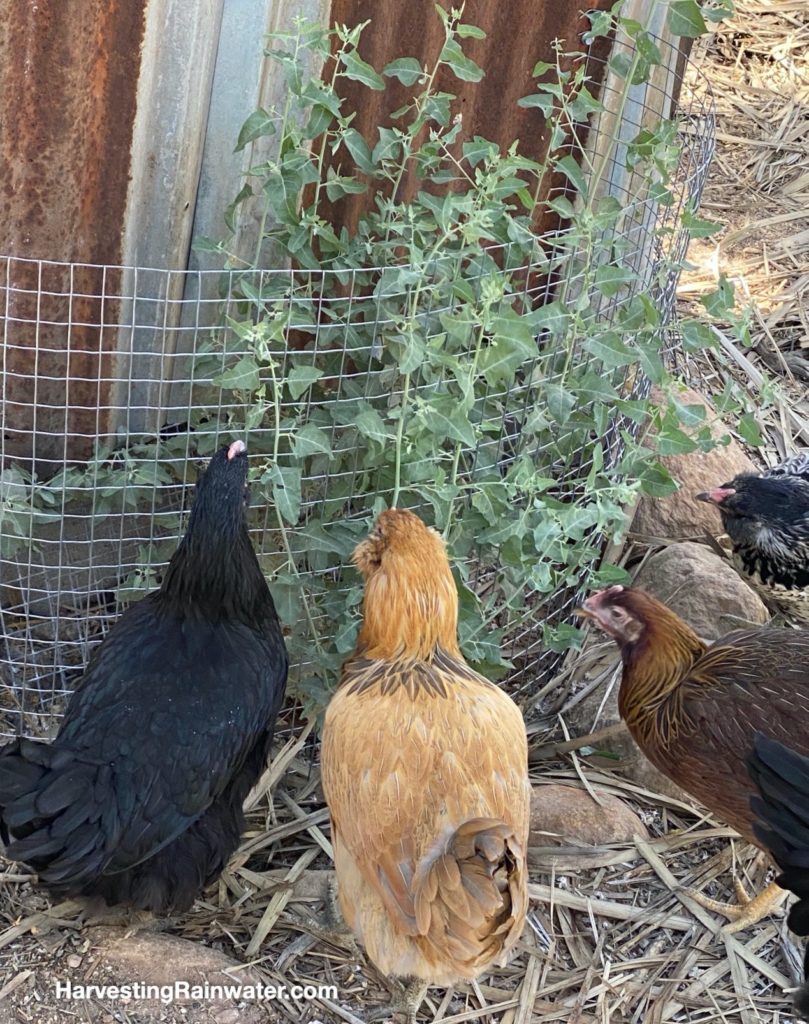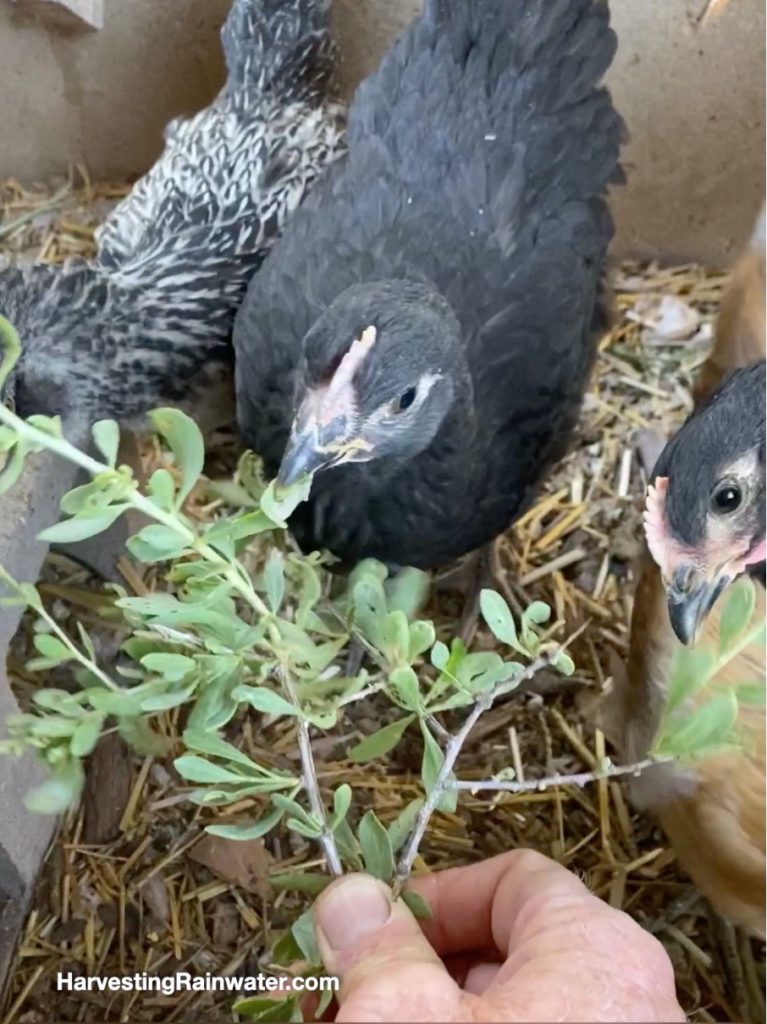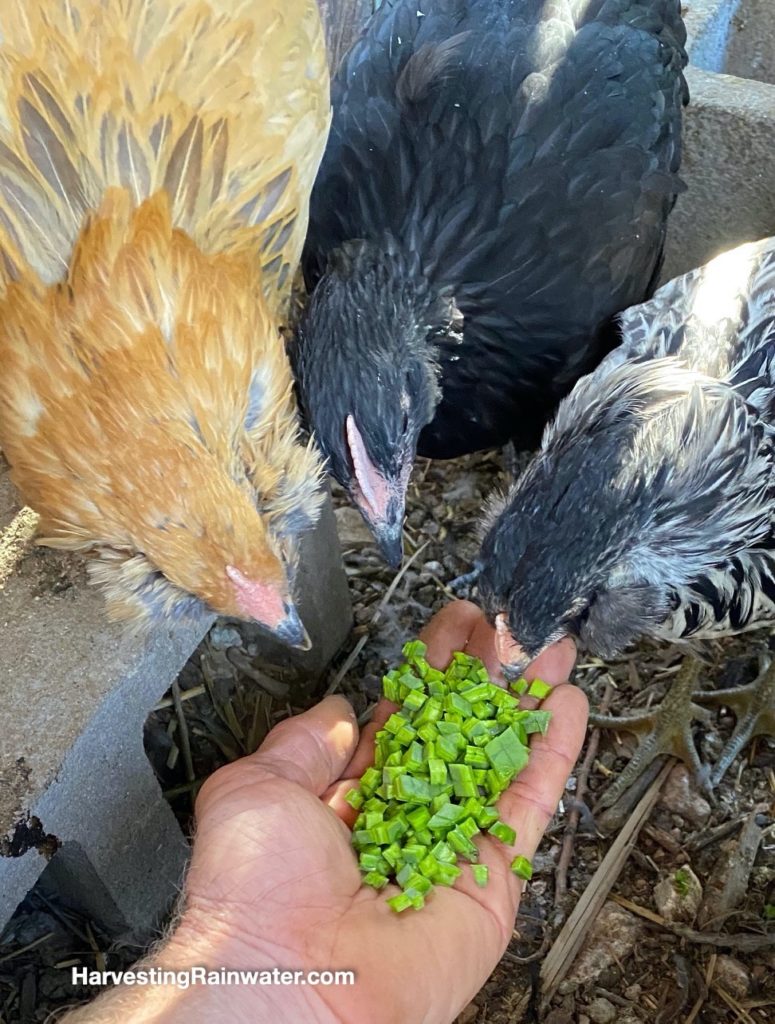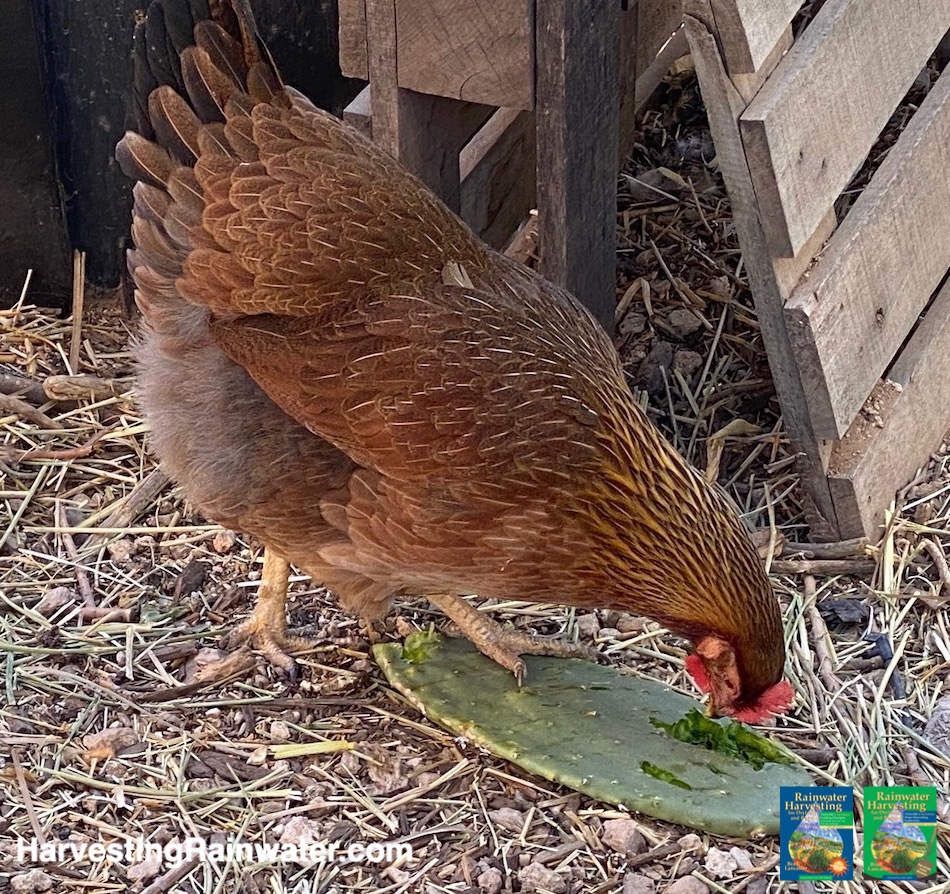Plants for chickens in the Sonoran Desert
Mostly native, plus a few exotic plants also loved by chickens. These plants grow well in Tucson, Phoenix, Hermosillo, and throughout the Sonoran Desert. All but the shortest plants provide shelter for the chickens in addition to food.
APPROXIMATE WATER NEEDS OF PLANTS (LW = low water 10 – 20 inches of water per year, MW = medium water 20 – 35 inches per year, HW = high water 35 – 50 inches per year) and numbers 1,2,3,or 4 signifying approximate irrigation needs of the plants ONCE THEY BECOME ESTABLISHED (this often takes from 2-3 years) – (“1” = no supplemental irrigation, “2” = once a month irrigation in growing season, “3” = twice a month irrigation in growing season, “4” = once a week during the growing season.
Compiled by Brad Lancaster 2004–2020
www.HarvestingRainwater.com
TREES
Canyon Hackberry (Celtis reticulata):
Ulmaceae – Elm Family
Terrace to Top rain garden planting zones. MW(2-3)
Grows to 30 feet; winter deciduous; fruits October to November; chickens love the fruit and we can eat it too. Less drought hardy.
Mexican Elderberry (Sambucus mexicana):
Caprifoliaceae – Honeysuckle Family
Terrace to Bottom rain garden planting zones LW(3)
Grows to 20 feet; summer deciduous; fruits May to October; chickens love the fruit and we can eat it too. Less drought hardy.
Texas Mulberry (Morus microphylla):
Moraceae – Mulberry Family
Terrace rain garden planting zones HW(3-4)
Grows from 3 to 26 feet; winter deciduous; fruits May to August; chickens love the fruit and we can eat it too. Less drought hardy.
Velvet Mesquite (Prosopis velutina):
Leguminosae – Pea Family
Terrace to Bottom rain garden planting zones LW(1)
Grows to 25 feet; semi-winter deciduos; fruits June to September; chickens eat the pods if they are first ground up into smaller pieces (you can do so in a blender or coffee grinder, but my chickens like the pods even more if I chew the pods up and then spit them out while I’m hanging out with the chickens in their run). We can eat the pods too – see the book Eat Mesquite and More for recipes and tips.
Desert Ironwood (Olyna tesota):
Leguminosae – Pea Family
Terrace to Top rain garden planting zones LW(1)
Grows to 25 feet; evergreen; fruits May-July; chickens eat the seeds and fresh flowers (and we can too).
SHRUBS
Barberry (Berberis hematocarpa and B. trifoliate):
Berberidaceae – Barberry Family.
Terrace to Top rain garden planting zones. MW(2-3).
Grows to 6 or 12 feet; evergreen; fruits Feb-May; chickens love the fruit and we can eat them too. A great medicinal plant.
Brickellia coulteri common to the Tucson Basin growning under palo verdes and mesquite.
Brickellia Californica found at elevations 3,000 – 7,000′Compositae – Sunflower Family
Terrace to Top rain garden planting zones. LW(2).
Grows to 2 – 3’. Chickens eat the foliage. Medicinal.
Attracts quail.
Chiltepine (Capsicum aviculare):
Solanaceae – Nightshade Family.
Terrace to Top rain garden planting zones. LW(3).
Grows 2 to 10 feet; evergreen, but frost sensitive; fruits August to November; chickens love the fruit (protect core of plant from chickens with fencing, chickens can eat what grows through fencing) and I love the fruit too!
Chuparosa (Justicia californica):
Acanthaceae – Acanthus Family.
Terrace to Top rain garden planting zones LW(2-3).
Grows 3 to 4 feet; deciduous; cold tolerance 28?F or -2?C; chickens eat the leaves and flowers (protect core of plant from chickens with fencing, chickens can eat what grows through fencing). We too can eat the cucumber-flavored flowers.
Hummingbirds delight in the blooms.
*Desert Hackberry (Celtis pallida):
Ulmacea – Elm Family.
Terrace to Top rain garden planting zones. LW(2).
Grows to 5 to 15 feet; semi-evergreen; fruits July-Sept; chickens eat the fruit and leaves. We too can eat the apricot-flavored fruit.
Nectar source for bees, butterflies, and moths. Larval source for butterflies. Native birds and small mammals enjoy the fruit.
Globe Mallow (Sphaeralcea ambigua):
Malvaceae – Mallow Family.
Terrace to Top rain garden planting zones. LW(1).Grows 1 to 3 feet; blooms typically orange, but can also be white, purple, pink, or red; chickens eat the foliage (protect core of plant from chickens with fencing, chickens can eat what grows through fencing).
Superstition Mallow (Abutilon palmeri):Malvaceae – Mallow Family. Terrace to Top rain garden planting zones LW(2-3).
Grows 2 to 5 feet; cold tolerant to low 20?s F; chickens eat the foliage (protect core of plant from chickens with fencing, chickens can eat what grows through fencing).
Yellow to orange flowers are a nectar source for bees, hummingbirds, moths, and butterflies.
Greythorn (Ziziphus obtusifolia):
Rhamnaceae – Buckthorn Family.
Terrace to Top rain garden planting zones. LW(1).
Evergreen, thorny, chickens eat the fruit when they can get to it. Great nesting habitat for native birds. Place along fencelines.
Jojoba (Simmondsia chinensis):
Simmondsiasceae.
Terrace to Top rain garden planting zones. LW(1).
Grows 3-16 feet; evergreen; fruiting time is variable; chickens reportedly eat the fruit (though I have not observed this).
*Quail Brush (Atriplex lentiformis):
Chenopodiaceae – Goosefoot Family.
Terrace to Top rain garden planting zones. LW(1)
Grows to 8 feet; evergreen; very fast growing chicken shelter, chickens eat the leaves, and sometimes eat the seeds.

*Wolfberry (Lycium fremontii):
Solanaceae – nightshade family.
Terrace to Top rain garden planting zones. LW(1).Grows to 5 feet; drought deciduous; fruits year round with enough moisture; chickens love the fruit and leaves. We can eat the fruit too. Note: other wolfberries work well too, but this native variety has the largest fruits.

VINES
Coyote Gourd (Cucurbita digitata):
Cucurbitaceae – Gourd Family
Terrace to Bottom rain garden planting zones LW(2)
Blooms June – October, prompted by rain. Winter and drought deciduous; chickens eat the leaves.
CACTI
Barrel cactus (Ferocactus wislizeni):Cactaceae – Cactus FamilyTop to Terrace rain garden planting zones LW(1)
Evergreen; chickens eat the seeds and fruit too if the fruit is cut up into 1/4-inch cubes. We can also eat the fruit and seeds.
Hedgehog (Echinocereus engelmanii):
Cactaceae – Cactus Family
Top to Terrace rain garden planting zones LW(1)
Evergreen; chickens love the fruit if you brush off the thorns first. We can eat the tasty fruit too.
Prickly pear (Opuntia engelmannii):
Cactaceae – Cactus Family
Top to Terrace rain garden planting zones LW(1)
Evergreen; chickens eat the fruit and seeds and we can too.
Saguaro (Carnegiea gigantean):
Cactaceae – Cactus Family
Top to Terrace rain garden planting zones LW(1)
Evergreen, fruits in June; chickens eat the fruit and seeds (once fruit has opened) and we can too.
ANNUALS
Chickens love to eat london rocket mustard, Sisymbrium irio; sow thistle, Sonchus oleraceus; winter grasses; bermuda grass (Cynodon dactylon); amaranth: Amaranthus palmeri and Amaranthus fimbriatus; red spiderling, Boerhavia coulteri; portulaca; and lambsquarters.
OTHER DROUGHT-TOLERANT CHICKEN-PLANTS NOT NATIVE TO TUCSON
Nopal (Opuntia ficus-indica):
Grows to 10 feet, evergreen; chickens especially like the younger tender pads, fruit, and seeds — and we can too, and they will eat the older mature pads as well.


Fan palm (Washington filifera):
Grows to 60 feet; evergreen; fruits December – January; chickens eat the fruit and we can too.
Pomegranate (Punica granatum):
Grows to 12 feet; winter deciduous; fruits June to October; chickens love the seeds (but you usually have to open the fruit up for them so they can access the seed) and we can eat the fruit too.
I wouldn’t plant it, but chickens love to eat Bermuda grass and will weed it for you.
* Indicated the best chicken plants
KITCHEN SCRAPS THE CHICKENS ENJOY
• Banana peels (from organically-grown bananas). They like them best when cut up in 1 to 2-inch pieces
• Any greens or cooked grains
• Spent grains and mash from brewing beer (or picked up from local breweries)
FOR GREAT ADDITIONAL INFO
Such as:
• how to irrigate these plants with free, on-site waters;
• how to effectively place these plants to shade/cool chickens, coops, homes, and gardens in summer,
• how to place these plants to warm chickens, coops, homes, and gardens in winter
• and more…
See the new, full-color, revised editions of Brad’s award-winning books:

Volume 1

